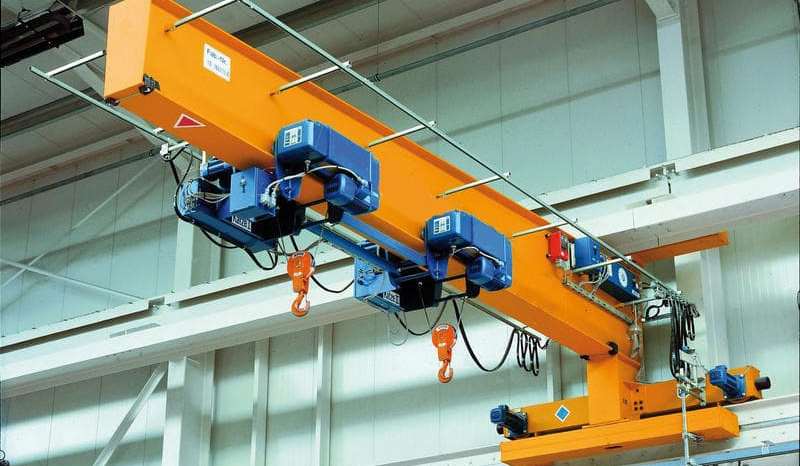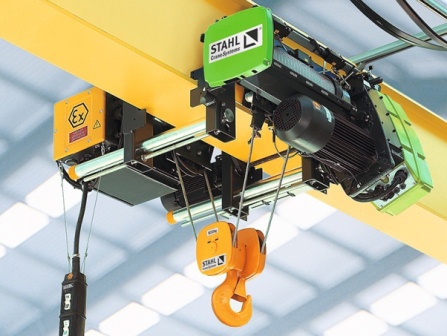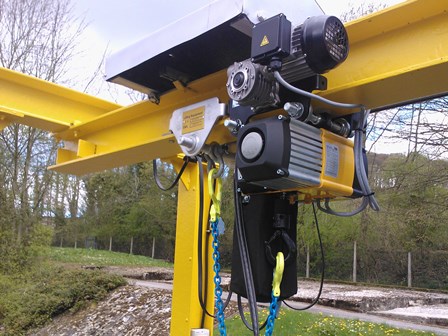The mechanism used to raise and lower heavy loads to the desired height with comparatively little effort is called a lifting mechanism.
It is mainly operated with a system of pulleys and gears (either manually or mechanically) using electric power or fuel.
How does the hoist mechanism work?
They are generally used for loading and unloading very heavy materials that cannot be handled by one person and must be placed on transport trucks, ships, fixed spaces and many other places.

Chain block mechanism
The ability to move the load relies on the system of pulleys and cables, which can be fixed or mobile. This system varies the forces and the speed, needing to apply a force less than the load to be moved. The effort is also less than what we would need if the load were lifted freehand or with small hoists.
A specific overhead hoist configuration is generally defined by the lifting medium, operation, and suspension.
Hoist is the type of component used to transmit and cause vertical movement and includes cable, chain or synthetic strap, or rope.
Operation defines the type of power used to operate the lifting motion and includes manual power, electrical power, hydraulic power, or pneumatic power.
Suspension defines the type of mounting method used to suspend the hoist and includes hook, clevis, lug, trolley, platform, base, wall, or ceiling.
How to calculate hoist load capacity?
Determination of the required capacity
When selecting a manual, chain, or electric hoist, the rated capacity should be at least as high as the weight of the heaviest load to be lifted and no higher than the rated capacity of the bracket, monorail system, or another overhead structure from which the hoist will be raised.
In addition to the factors listed above for manual hoists, when determining the capacity requirement for an electric or air hoist, we must not only consider the weight of the heaviest load to be lifted, but also determine the average effective load.
Suspension kit for hoisting
Chain hoists can be suspended in a fixed location or can be mounted to a trolley by means of a top hook or mounting lug.
The cars can be rigid or articulated. Trolley travel can be simple (push type), manual geared or motor driven. See below for examples of typical chain hoist suspension types.
How does the lift system work?
When the corresponding button or joystick on the pendant or radio is activated, the hook moves vertically as long as certain conditions are met.
The product has a variety of built-in automatic safety features that, for example, prevent lifting overload, limit travel movements, or prevent all movements if the emergency stop button is activated.
Additionally, there may be operational limits (set by the owner or operator) that also limit movements under certain conditions.
Complete suspension kit for hoist
When a joystick or lift button is activated on the controller, a command is sent to the electrical panel.
The direction (up or down) of the hoist depends on which button or joystick is pressed. The speed of the hoist depends on the step that is activated.
The electrical panel controls the brake and the motor according to operator inputs, along with signals from sensors and safety devices.
When the motor is not being driven, the brake holds the motor in place, preventing it from turning inadvertently and the load from slipping down.
When a signal is transmitted from the controller, the electrical panel powers the motor and releases the brake.
- The motor drives the lifting mechanism which drives the lifting drum.
- The hoist mechanism reduces rotational speed and increases torque to lift the load.
- The wire rope winds or unwinds when the hoist drum rotates.
- The cable guide guides the steel cable to the correct groove on the drum.
- One end of the cable is fixed to the lifting drum with a cable clamp.
- The other end of the rope connects to the rope anchor.
- The cable passes around the cable pulleys to the cable anchor.
- The hook block raises and lowers as the cable is spooled on or off the hoist drum.
In normal use, when the raise or lower control on the controller is released, the control closes the main brake and brings the hoist to a gradual and controlled stop.
In emergency situations, the emergency stop button on the controller can be activated. This causes an instant stop of all movements by cutting power to the motors and applying the brakes.

Types of hoists
A hoist is basically construction and material handling equipment that is used to move the materials from the building’s ground to the top floor.

Electric Hoist Trolley
Electric Hoist trolley provides the ability for a simple hoist to become a laterally traversing versatile piece of equipment. Powered trolley hoists come in different types, including air and electric and capacities.

I Beam Trolley Hoist
An I-beam trolley is a wheel mechanism from which a hoist is suspended to provide horizontal movement of the hoist along a beam or bridge rail.
